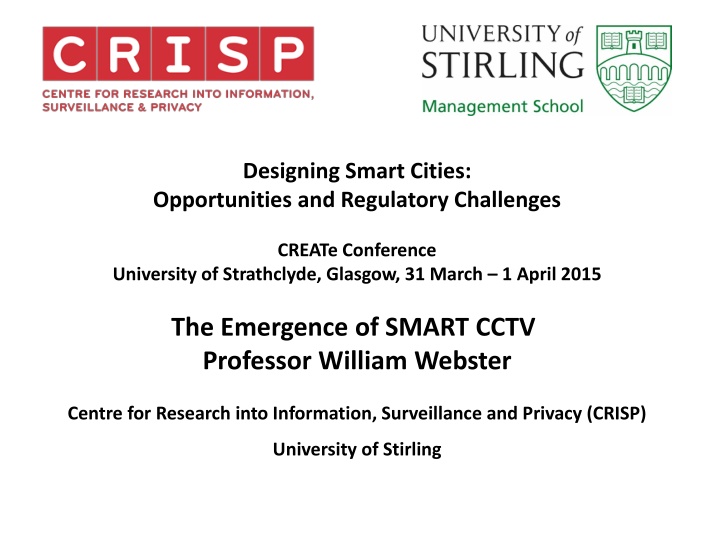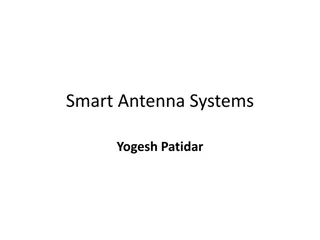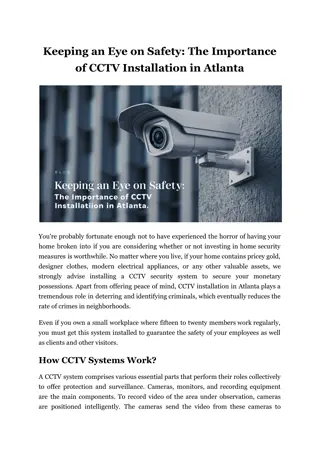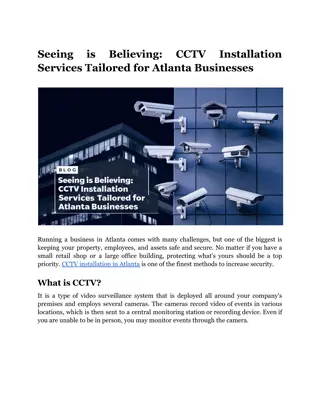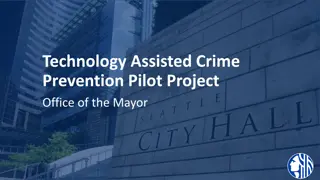Smart CCTV Systems: Opportunities and Challenges
Explore the components and typology of Smart CCTV Systems, including proactive, reactive, non-active, and auto-active types. Learn about the smart developments in CCTV such as integration, digitization, automation, expansion, and standardization.
Uploaded on Mar 16, 2025 | 0 Views
Download Presentation

Please find below an Image/Link to download the presentation.
The content on the website is provided AS IS for your information and personal use only. It may not be sold, licensed, or shared on other websites without obtaining consent from the author.If you encounter any issues during the download, it is possible that the publisher has removed the file from their server.
You are allowed to download the files provided on this website for personal or commercial use, subject to the condition that they are used lawfully. All files are the property of their respective owners.
The content on the website is provided AS IS for your information and personal use only. It may not be sold, licensed, or shared on other websites without obtaining consent from the author.
E N D
Presentation Transcript
Designing Smart Cities: Opportunities and Regulatory Challenges CREATe Conference University of Strathclyde, Glasgow, 31 March 1 April 2015 The Emergence of SMART CCTV Professor William Webster Centre for Research into Information, Surveillance and Privacy (CRISP) University of Stirling
Components of a CCTV System Camera (lens), fixed or mobile, analogue or digital Telecoms infrastructure Visual display equipment, including camera controls Recording and storage equipment Control centre and storage facility Street furniture, including signage Operators, including operational training, skills and surveillance practices (monitoring protocols and norms) Operational guides, including Codes of Practice Regulation, including legislation Management processes, financial and performance indicators Accountability and oversight arrangements Links to criminal justice system
So, What Makes a Smart CCTV System? A CCTV system that is: More effective (at what?) More powerful? More sophisticated? More technologically advanced? Multi-functional or multi-purpose? More intelligent? Easier to use? Less invasive? Privacy enhancing? Cheaper?
A Typology of Public Space CCTV Type Features Proactive Live surveillance from a dedicated control room with recording, storage and playback facilities. Allows for an immediate response to incidents as they occur. Reactive Recording, storage and playback facilities. Provides access to footage of incidents after the event has occurred. Non-active No monitoring, storage or playback facilities. Acts as a visual deterrent by using fake cameras to create the illusion of surveillance. Auto-active Smart Live computerised surveillance incorporating automated intelligent systems. Can include data-matching.
Smart Developments in CCTV - integration - digitisation - automation - - expansion - standardisation - computerisation - Integration and standardisation of existing systems and practices Centralised control centres Expansion and new technological components Drones, head cams, mobile cameras, body worn cameras Other sensors, infra-red, microwave, heat, sniffing, listening Image recognition and analysis (Smart CCTV) Face, movement and activity recognition Object tracking and analysis ANPR systems Noise analysis Sophisticated integrated surveillance systems Virtual tracking, identification and profiling
Smart CCTV No agreed definition of Smart CCTV A visual surveillance system that is integrated with other ICTs and is capable of automatically processing images alongside other digital information for predefined purposes Image analysis New sensory devices New data integration capabilities Perceived to be more intelligent Allows for mass real (or real-time) surveillance, smaller human intervention (reduces cost) and quicker decisions
Privacy Friendly Smart CCTV Can smart technologies be used to enhance aspects of privacy? The blurring of personal data (faces) Retrospective unmasking The masking of personal space and property CCTV app s and web-mapping Sleeping cameras CCTV operator performance management systems Targeted surveillance ANPR automated deletion of records
Issues and Implications Are citizens the surveyed aware of what cameras and systems do? Is there a need for greater public awareness and is this linked to the acceptability of systems? Would attitudes change is there was greater awareness of the smartness of systems? To what extent are Smart CCTV systems a greater infringement on privacy than normal systems? How smart is smart how reliable are smart systems? Is there robust evidence that Smart CCTV is more effective? Is Smart CCTV a good example of function creep ? Does regulation need to evolve as the technology becomes smarter? How many systems are evolving into Smart CCTV systems? How do providers identify the most appropriate Smart CCTV systems? What are the driving forces for introducing Smart CCTV?
